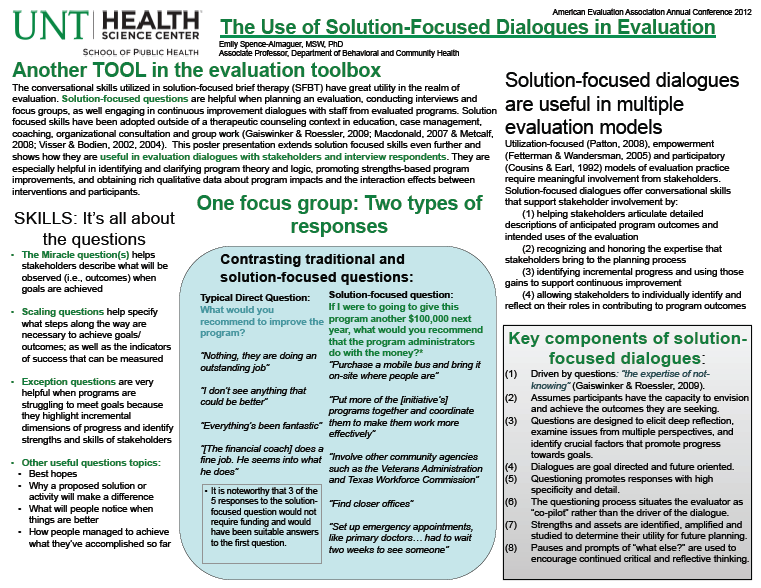My name is Emily Spence-Almaguer and I am an Associate Professor of Behavioral and Community Health at the University of North Texas Health Science Center. I spend most of my professional time serving as an independent evaluator for community initiatives and conducting assessment studies. I am a social worker by training and have found that the conversational skills used in Solution-Focused Therapy have great application in the realm of evaluation and community assessment.
Hot Tips: My favorite ways to use solution-focused dialogues are in:
- Focus group and individual interviews because they help generate rich qualitative data and great ideas for continuous program improvements.
- Evaluation planning meetings because they help stakeholders articulate a wide range of potential outcomes and describe how those outcomes might be observed (i.e., measured).
- Meetings where stakeholders are being debriefed around disappointing evaluation results. The nature of solution-focused dialogues avoids finger-pointing and helps drive forward momentum.
Hot Tips:
- It’s all about the questions!! Solution-focused dialogues are driven by questions that promote deep reflection and critical thinking.
- Context: Use questions that help situate people’s minds in a particular context and use details in your question that will encourage an individual to imagine him or herself in that moment. Here’s an example that I use with consumers at a program trying to help lift individuals and families out of poverty:
- I want you to take a moment and imagine that you just learned that the Bass [local philanthropist] family recently donated $100,000 to the United Way for this project. They want you to help them figure out how to best spend the money. What is the first thing you would advise them to do? What would you advise them to do next?
- Expertise: I love the way that Gaiswinker and Roessler referred to this as the “expertise of not-knowing”. In solution-focused dialogues the words of questions and tone of delivery are carefully crafted to amplify the assumption that the stakeholders have exceptional knowledge, skills and capacities.
Rad Resource: For an introduction to solution focused concepts, I like Coert Visser’s Doing What Works Blog.

Rad Resource: I presented on Solution-Focused dialogues in evaluation at AEA’s Evaluation 2012 conference. You can download my poster and resources list from the AEA public eLibrary here.
Lessons Learned: A direct question, such as “What would you recommend to improve this program?” often fails to generate detailed or meaningful responses. In focus groups with program consumers, I find that this question is interpreted as “what is wrong with the program?” and may lead to comments in defense of the program staff members (see my 2012 AEA poster for an example of this from my data).
The American Evaluation Association is celebrating Best of aea365, an occasional series. The contributions for Best of aea365 are reposts of great blog articles from our earlier years. Do you have questions, concerns, kudos, or content to extend this aea365 contribution? Please add them in the comments section for this post on the aea365 webpage so that we may enrich our community of practice. Would you like to submit an aea365 Tip? Please send a note of interest to aea365@eval.org . aea365 is sponsored by the American Evaluation Association and provides a Tip-a-Day by and for evaluators.

Many thanks, Emily. This will be a useful tool for both Outcome Mapping (www.outcomemapping.ca) and Outcome Harvesting. I am posting to both communities of practice and wanted to cc you but do not have your email address.
Ricardo